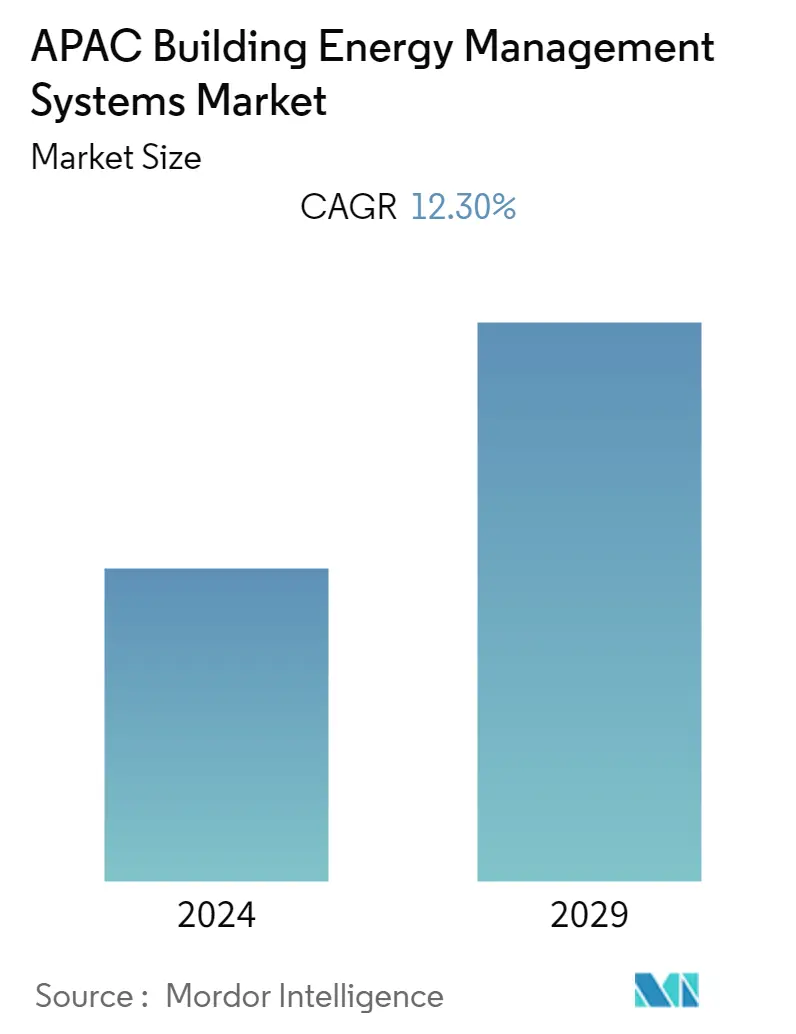Market Size of APAC Building Energy Management Systems Industry

| Study Period | 2019 - 2029 |
| Base Year For Estimation | 2023 |
| CAGR | 12.30 % |
| Fastest Growing Market | Asia-Pacific |
| Largest Market | North America |
| Market Concentration | Medium |
Major Players
*Disclaimer: Major Players sorted in no particular order |
APAC Building Energy Management Systems Market Analysis
The Asia-Pacific Building Energy Management System (BEMS) Market is anticipated to register a CAGR of 12.3% during the forecast period. The increasing demand for reduction in energy consumption level and continuing growth of energy use, owing to a rising number of commercial buildings, created a need to develop innovative techniques to reduce and optimize building energy use.
- Bigger buildings require advanced building and predictive analytics, building optimization and continuous optimization, demand response, automated building control, auto, and enterprise integration, while small-sized buildings require a system that can provide information on incentive availability, historical billing analysis, and behavioural, educational, and retrofit suggestions. BEMS plays a crucial role in fulfilling these requirements. Companies are also offering BEMS solutions for medium-sized buildings, in which they are providing energy monitoring, retro and continuous commissioning, NOC availability, maintenance, trouble ticket management, AMI data analysis, and retrofit program suggestions.
- As China's economy expands quickly, the building sector in that country is witnessing an unprecedented boom. This directly affects China's levels of greenhouse gas emissions (GHG) brought on by energy usage in buildings. In October 2021, China's Ministry of Housing and Urban-Rural Development issued national standards for energy conservation and renewable energy use in buildings to enhance the energy efficiency, promote renewable energy, and reduce carbon emissions of buildings. To assist decision-makers in developing building energy performance policy packages that can enhance the energy performance of new and existing buildings in China and restrain the rise of building-related CO2 emissions could boost the growth of the studied market.
- Singapore is also at the forefront of forming favorable government initiatives to support the adoption of smart buildings. Coupled with its Smart Nation initiative, the government introduced the Green Mark Scheme with a target of 80% of buildings to be certified as green under this scheme by 2030. Such initiatives are likely to augment the demand for building energy management systems in the region.
- The Asia Pacific region is also witnessing several innovations catering to efficient energy management for buildings through investments in R&D, collaborations, and mergers. For instance, in October 2022, Tata Power Trading Company announced that it signed an agreement with 75F Smart Innovations India to jointly promote building automation and energy-efficiency solutions in the commercial building space. 75F Smart Innovations is a prominent Internet of Things (IoT)-based building management system firm headquartered in Washington DC. TPTCL, a wholly-owned subsidiary of Tata Power, announced that it would collaborate with 75F Smart Innovations India to offer energy-efficiency solutions across industry verticals, including IT/information technology-enabled services (ITeS), banking financial services and insurance (BFSI), hospitality, health care, education, government, and retail.
- With the growth of technology, smart buildings are growing more and more complex, requiring quicker follow-up looks via retro-commissioning. Adding to that, the risks associated with sustained operational integrity are also mounting. Hence, the demand for comprehensive building energy management systems is expected to spike. It is very important to establish necessary communication between the system providers/designers and owners of the buildings, to understand the functioning of the building. However, market growth is expected to be hindered due to a lack of competent experts skilled in assessing smart solution systems. Professionals operating in the field need to be aware of the design changes and installation in the context of future needs. Failing to do so may lead to complications.
- Moreover, the Covid-19 outbreak has hampered the growth of the building energy management system solution industry due to lockdown measures in the region and delays in the manufacturing and production of BEM products and solutions used in HVAC and non-HVAC applications. The pandemic has also heightened attention on resilience and how society and vital sectors, such as the energy supply, may improve their ability to withstand shocks like the COVID-19 pandemic.
APAC Building Energy Management Systems Industry Segmentation
Building Energy Management Systems are integrated, computerized systems for monitoring and controlling energy-related building services plant and equipment like heating, ventilation, air conditioning (HVAC) systems, lighting, power systems, etc.
The Asia-Pacific Building Energy Management Systems Market is Segmented by Type of Solution (Hardware, Software, Services), Distribution Channel (Direct/Partner Sales/Retail, Direct/Partner Sales/Retail, Utilities/Energy Service Providers), End-user Application (Commercial, Educational, Industrial), and Country. The scope of the study tracks the revenue accrued from the sale of building energy management systems (BEMS), which includes hardware products and software applications. The content of the survey comprises controllers/gateways and energy optimization software. The market sizes and forecasts regarding value (USD million) for all the above segments are provided.
| By Type of Solution | |
| Hardware (controllers and gateways) | |
| Software | |
| Services |
| By Distribution Channel | |
| Direct/Partner Sales/Retail | |
| Value-added Resellers/System Integrators | |
| Utilities/Energy Service Providers |
| By End-user Application | |
| Commercial | |
| Educational | |
| Industrial | |
| Others |
| By Country | |||||||
| China | |||||||
| Japan | |||||||
| |||||||
| Rest of Asia-Pacific |
APAC Building Energy Management Systems Market Size Summary
The Asia-Pacific Building Energy Management Systems (BEMS) market is experiencing significant growth, driven by the increasing need to optimize energy consumption in response to the rising number of commercial and residential buildings. This demand is further fueled by the expansion of smart cities and the adoption of advanced technologies aimed at enhancing energy efficiency. Countries like China and Singapore are at the forefront, implementing national standards and initiatives to promote energy conservation and renewable energy use in buildings. The region is witnessing a surge in innovations and collaborations among key players, such as Tata Power Trading Company and 75F Smart Innovations, to develop and promote energy-efficient solutions across various sectors. These efforts are supported by government policies and regulations that encourage the adoption of smart building technologies and energy management systems.
The market is characterized by a moderate level of fragmentation, with major players like Siemens AG, Honeywell, ABB Ltd., and Schneider Electric actively investing in research and development to introduce new products and services. These companies are also expanding their geographic reach through strategic partnerships and collaborations. Despite the challenges posed by the COVID-19 pandemic, which temporarily hindered market growth due to supply chain disruptions, the demand for comprehensive BEMS solutions is expected to rise. This is attributed to the growing complexity of smart buildings and the need for efficient energy management to ensure operational integrity. The market's growth is further supported by the increasing focus on sustainability and carbon reduction, as evidenced by various government initiatives and industry collaborations across the Asia-Pacific region.
APAC Building Energy Management Systems Market Size - Table of Contents
-
1. MARKET INSIGHTS
-
1.1 Market Overview
-
1.2 Technological Advancements
-
1.3 Industry Attractiveness - Porter's Five Force Analysis
-
1.3.1 Threat of New Entrants
-
1.3.2 Bargaining Power of Buyers
-
1.3.3 Bargaining Power of Suppliers
-
1.3.4 Threat of Substitute Products
-
1.3.5 Intensity of Competitive Rivalry
-
-
1.4 Industry Supply Chain Analysis
-
1.5 Impact of COVID-19 on the Market
-
-
2. MARKET SEGMENTATION
-
2.1 By Type of Solution
-
2.1.1 Hardware (controllers and gateways)
-
2.1.2 Software
-
2.1.3 Services
-
-
2.2 By Distribution Channel
-
2.2.1 Direct/Partner Sales/Retail
-
2.2.2 Value-added Resellers/System Integrators
-
2.2.3 Utilities/Energy Service Providers
-
-
2.3 By End-user Application
-
2.3.1 Commercial
-
2.3.2 Educational
-
2.3.3 Industrial
-
2.3.4 Others
-
-
2.4 By Country
-
2.4.1 China
-
2.4.2 Japan
-
2.4.3 Southeast Asia
-
2.4.3.1 Singapore
-
2.4.3.2 Malaysia
-
2.4.3.3 Thailand
-
2.4.3.4 Indonesia
-
2.4.3.5 Rest of Southeast Asia
-
-
2.4.4 Rest of Asia-Pacific
-
-
APAC Building Energy Management Systems Market Size FAQs
What is the current APAC Building Energy Management Systems Market size?
The APAC Building Energy Management Systems Market is projected to register a CAGR of 12.30% during the forecast period (2024-2029)
Who are the key players in APAC Building Energy Management Systems Market?
Siemens AG, Honeywell International Inc. , Schneider Electric SE, Johnson Controls and ABB Ltd. are the major companies operating in the APAC Building Energy Management Systems Market.

